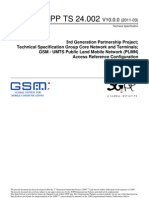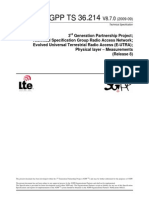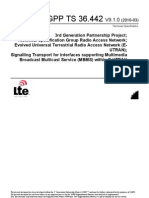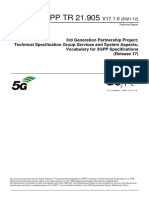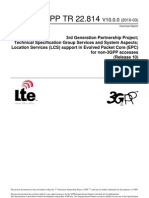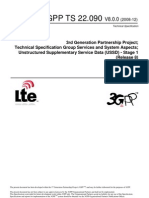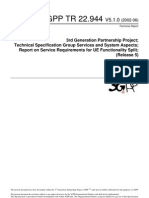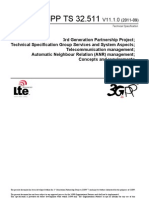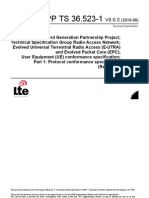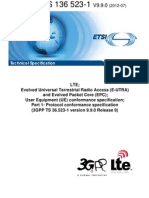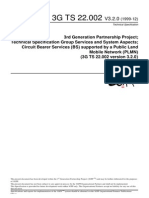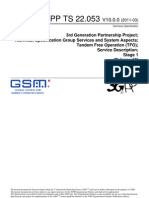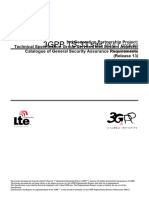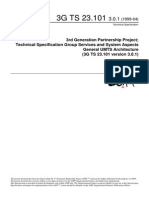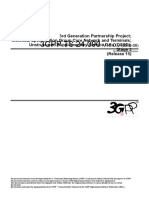3GPP TS 24.002
3GPP TS 24.002
Uploaded by
qwxdqwdxwqCopyright:
Available Formats
3GPP TS 24.002
3GPP TS 24.002
Uploaded by
qwxdqwdxwqOriginal Title
Copyright
Available Formats
Share this document
Did you find this document useful?
Is this content inappropriate?
Copyright:
Available Formats
3GPP TS 24.002
3GPP TS 24.002
Uploaded by
qwxdqwdxwqCopyright:
Available Formats
3GPP TS 24.002 V8.1.
0 (2009-03)
Technical Specification
3rd Generation Partnership Project; Technical Specification Group Core Network and Terminals; GSM - UMTS Public Land Mobile Network (PLMN) Access Reference Configuration (Release 8)
The present document has been developed within the 3rd Generation Partnership Project (3GPP TM) and may be further elaborated for the purposes of 3GPP. The present document has not been subject to any approval process by the 3GPP Organisational Partners and shall not be implemented. This Specification is provided for future development work within 3GPP only. The Organisational Partners accept no liability for any use of this Specification. Specifications and reports for implementation of the 3GPP TM system should be obtained via the 3GPP Organisational Partners' Publications Offices.
Release 8
3GPP TS 24.002 V8.1.0 (2009-03)
Keywords
GSM, UMTS, network, architecture, LTE
3GPP Postal address 3GPP support office address
650 Route des Lucioles - Sophia Antipolis Valbonne - FRANCE Tel.: +33 4 92 94 42 00 Fax: +33 4 93 65 47 16
Internet
http://www.3gpp.org
Copyright Notification No part may be reproduced except as authorized by written permission. The copyright and the foregoing restriction extend to reproduction in all media.
2009, 3GPP Organizational Partners (ARIB, ATIS, CCSA, ETSI, TTA, TTC). All rights reserved. UMTS is a Trade Mark of ETSI registered for the benefit of its members 3GPP is a Trade Mark of ETSI registered for the benefit of its Members and of the 3GPP Organizational Partners LTE is a Trade Mark of ETSI currently being registered for the benefit of its Members and of the 3GPP Organizational Partners GSM and the GSM logo are registered and owned by the GSM Association
3GPP
Release 8
3GPP TS 24.002 V8.1.0 (2009-03)
Contents
Contents....................................................................................................................................................3 Foreword...................................................................................................................................................4 1 Scope......................................................................................................................................................5
1.1 References..............................................................................................................................................................5 1.2 Abbreviations.........................................................................................................................................................6
2 General definitions.................................................................................................................................6
2.1 Reference Configurations.......................................................................................................................................7 2.2 Functional Groups..................................................................................................................................................7 2.3 Reference Points.....................................................................................................................................................7 2.4 Interface Points ......................................................................................................................................................7 2.5 Terminal Definitions..............................................................................................................................................7
3 Reference Configuration........................................................................................................................8
3.0 General...................................................................................................................................................................8 3.1 Mobile Termination (MT)......................................................................................................................................9 3.2 Void 10
4 Physical Realisation.............................................................................................................................10 Annex A (informative): Change history......................................................................................11
3GPP
Release 8
3GPP TS 24.002 V8.1.0 (2009-03)
Foreword
This Technical Specification has been produced by the 3rd Generation Partnership Project (3GPP). The contents of the present document are subject to continuing work within the TSG and may change following formal TSG approval. Should the TSG modify the contents of the present document, it will be re-released by the TSG with an identifying change of release date and an increase in version number as follows: Version x.y.z where: x the first digit: 1 presented to TSG for information; 2 presented to TSG for approval; 3 or greater indicates TSG approved document under change control. y the second digit is incremented for all changes of substance, i.e. technical enhancements, corrections, updates, etc. z the third digit is incremented when editorial only changes have been incorporated in the document.
3GPP
Release 8
3GPP TS 24.002 V8.1.0 (2009-03)
1 Scope
The present document describes the reference configuration for access to a PLMN. A user accesses a PLMN via a number of interfaces, including the MS-BS (in A/Gb mode and GERAN Iu mode), UEUTRAN (in UTRAN Iu mode) and UE-E-UTRAN interface. The purpose of this document is to indicate the possible access arrangements that may be used in conjunction with the MS-BS (in A/Gb mode and GERAN Iu mode), UEUTRAN (in UTRAN Iu mode) and UE-E - UTRAN interface.
1.1 References
The following documents contain provisions which, through reference in this text, constitute provisions of the present document. References are either specific (identified by date of publication, edition number, version number, etc.) or non-specific. For a specific reference, subsequent revisions do not apply. For a non-specific reference, the latest version applies. In the case of a reference to a 3GPP document (including a GSM document), a non-specific reference implicitly refers to the latest version of that document in the same Release as the present document. [1] [2] [3] [4] [5] [6] [7] [8] [9] [10] [11] [12] [13] [14] [15] [16] [17] [18] [19] [20] Void. Void. Void. Void. Void. Void. Void. Void. Void. Void. Void. Void. Void. 3GPP TS 44.021: "Rate adaption on the Mobile Station - Base Station System (MS - BSS) interface". Void. Void. Void. Void. Void. Void.
3GPP
Release 8
3GPP TS 24.002 V8.1.0 (2009-03)
[21] [22] [23] [24] [25] [26] [27] [28] [29] [30] [31] [32] [33] [34] [35] [36] [37] [38] [39] [40] [41] [42] [43] [44] [45] [46]
Void. Void. Void. Void. Void. Void. Void. Void. Void. Void. Void. Void. 3GPP TS 27.001: "General on Terminal Adaptation Functions (TAF) for Mobile Stations (MS)". 3GPP TS 27.002: "Terminal Adaptation Functions (TAF) for services using asynchronous bearer capabilities". 3GPP TS 27.003: "Terminal Adaptation Functions (TAF) for services using synchronous bearer capabilities". Void. Void. Void. 3GPP TR 21.905: " Vocabulary for 3GPP Specifications ". Void. 3GPP TS 25.322: "Radio Link Control (RLC) Protocol Specification". ITU-T Recommendation V.24 (1996):"List of definitions for interchange circuits between data terminal equipment (DTE) and data circuit-terminating equipment (DCE)". ITU-T Recommendation V.28 (1993): "Electrical characteristics for unbalanced double-current interchange circuits". Infrared Data Association IrDA: "IrPHY Physical layer signalling standard". Personal Computer Memory Card Association: "PCMCIA 2.1 or PC-Card 3.0 electrical specification or later revisions". Void.
1.2 Abbreviations
Abbreviations used in the present document are listed in 3GPP TR 21.905 [39].
2 General definitions
The following definitions 2.1-2.3 are based on those used for ISDN.
3GPP
Release 8
3GPP TS 24.002 V8.1.0 (2009-03)
2.1 Reference Configurations
Reference Configurations are conceptual configurations useful in identifying access arrangements to a network. Two concepts are used in defining reference configurations: reference points and functional groups.
2.2 Functional Groups
Functional Groups are sets of functions which may be needed in network access arrangements. In a particular access arrangement, specific functions in a functional group may or may not be present. Specific functions in a functional group may be performed in one or more pieces of equipment.
2.3 Reference Points
Reference Points are the conceptual points dividing functional groups. In a specific access arrangement, a reference point may correspond to a physical interface between pieces of equipment, or there may not be any physical interface corresponding to the reference point.
2.4 Interface Points
Interface Points are reference points within a PLMN at which a 3GPP specified interface is always identified.
2.5 Terminal Definitions
The term 'mobile station' ( MS ) in the present document is synonymous with the term 'user equipment' (UE ) in 3G terminology as defined in 3GPP TR 21.905 [39]. The term 'TE2' in the present document is synonymous with the term 'TE' in 3G terminology as defined in 3GPP TR 21.905 [39]. The term 'MT2' in the present document is synonymous with the term 'MT' in 3G terminology as defined in 3GPP TR 21.905 [39].
3GPP
Release 8
3GPP TS 24.002 V8.1.0 (2009-03)
3 Reference Configuration
3.0 General
The reference configuration for PLMN (in A/Gb mode and GERAN Iu mode) access interfaces is shown in figure 1.
MS
MT0
BSS/MSC
TE2 R
: TE2: TA: GERAN: CN: reference point. V -type terminal. Terminal Adaptor. GSM/EDGE Radio Access Network. Core Network.
MT2 TA Um
BSS/MSC
Figure 1: PLMN Access Reference Configuration (in A/Gb mode and GERAN Iu mode) There are two types of MT: MT0 includes functions belonging to the functional group MT, with support of no terminal interfaces. MT2 includes functions belonging to the functional group MT, and with an interface that complies with the 3GPP TS 27.00z series Terminal Adaptation Function specifications [33], [34], [35]. Accordingly, the interchange circuit mapping at the MT2 to TE interface shall comply with the ITU-T V.24 [42] recommendation; while the physical implementation shall conform either to the ITU-T V.28 [43], or to the IrDA IrPHY Physical signalling standard specification [44], or to the PCMCIA 2.1 [45], or to the PC-Card 3.0 [45], electrical specification or to later revisions.
The MT plus any TE constitutes the Mobile Station, MS. The terminal equipment functional groups TE2 and TA are conceptually the same functional groups as those in the ISDN. The reference configuration for PLMN (Iu mode) access interfaces is shown in figure 2.
3GPP
Release 8
3GPP TS 24.002 V8.1.0 (2009-03)
UE ME MT USIM Cc TE TA Uu UTRAN or E-UTRAN/CN
: reference point. TA: Terminal Adaptor. MT: Mobile Termination. ME: Mobile Equipment. UE: User Equipment UTRAN: UMTS Radio Access Network. E-UTRAN:Evolved UMTS Radio Access Network. CN: Core Network.
Figure 2: PLMN Access Reference Configuration (UTRAN Iu mode or E-UTRAN) There is no reference point identified for the TA Function. The TA Function is considered as a part of the Mobile Termination and with an interface that complies with the 3GPP TS 27.00z series Terminal Adaptation Function specifications [33], [34], [35].
3.1 Mobile Termination (MT)
The MT performs the following functions, which performs the following functions: radio transmission termination; radio transmission channel management; terminal capabilities, including presentation of a man-machine interface to a user; speech encoding/decoding; error protection for all information sent across the radio path. This includes FEC (forward error correction) and, for signalling and user data (except for transparent data services), ARQ (automatic request for retransmission); flow control of signalling and mapping of user signalling to/from PLMN access signalling; flow control of user data (except for transparent data services) and mapping of flow control for asynchronous transparent data services; rate adaptation of user data (see 3GPP TS 44.021[14]) and data formatting for the transmission SAP (3GPP TS 25.322 [41]); multiple terminal support; mobility management.
3GPP
Release 8
10
3GPP TS 24.002 V8.1.0 (2009-03)
3.2 Void
4 Physical Realisation
In a PLMN, the reference point Um/Uu is an interface point, i.e. it is always implemented as a physical interface (according to 3GPP Technical Specifications in the 44, 45, 24, 25 and 36 series). The R reference point may be optionally implemented as physical interface. The implementation of interfaces at this reference point is according to 3GPP TS 27.001 [33], 3GPP TS 27.002 [34] and 3GPP TS 27.003 [35]. Figure 3 gives examples of configurations illustrating combinations of physical interfaces at the R reference point. The examples shown are not exhaustive, but only serve to illustrate possible implementations of the respective functional blocks. Example (a) of figure 3 illustrates a fully integrated MS including data terminal functions within the mobile station equipment. Example (c) of figure 3 illustrates the connection of a TE2 by an ITU-T V series interface according to 3GPP TS 27.002 [34] and 3GPP TS 27.003 [35]. Example (d) of figure 3 illustrates the connection of a MT2 PCMCIA card to a TE2 by a PCMCIA 2.1 interface according to 3GPP TS 27.002 [34]and 3GPP TS 27.003 [35]. Example (f) of figure 3 illustrates the connection of a speech only MS.
(a)
+---------------------+ +-----------+ | Mobile | | | | Data +-----//--| Base | | Terminal [MT0] | | Station | +---------------------+ +-----------+ void +----------------+ +-------+ +-----------+ | V | | | | | | DTE +----------//--| [MT2] +--//--| Base | | [TE2] | | | | Station | +----------------+ +-------+ +-----------+ +----------------+ +-------+ +-----------+ | V.24 | | | | | | and PCMCIA 2.1 | | | | | | DTE +-------------//-| [MT2] +-//-| Base | | [TE2] | | | | Station | +----------------+ +-------+ +-----------+ void +---------------------+ +-----------+ | Speech-only MS | | | | +-----//--| Base | | [MT0] | | Station | +---------------------+ +-----------+
(b)
(c)
(d)
(e)
(f)
Figure 3: Examples of physical implementations
3GPP
Release 8
11
3GPP TS 24.002 V8.1.0 (2009-03)
Annex A (informative): Change history
Change history
Date 30.3.2000 12-2000 03-2001 06-2002 03-2003 06-2003 12-2004 TSG # CN#7 NP-10 NP-11 NP-16 NP-19 NP-030044 003 1 TSG Doc. CR NP-000673 001 Rev Subject/Comment Transferred to 3GPP for R99 (from GSM 04.02 v7.0.0). 2 CR 24.002 on Adaptations for UMTS Old New 3.0.0
NP-26
03-2009 03-2009
CP-43 CP-43
CP-090243 000 4 CP-090159 000 5
TSG CN#11 decided to issue RELEASE 4 of the specification 3GPP TS 24.002 CN#16 decided to issue this TS also for Release 5. Additionally MCC made editorial and reference updates. Removal of the S reference point within the MS Corrected the coverpage and some formatting,- MCC editorial. Rel-6 published after CN#26 Upgraded to Rel-7 by MCC Upgraded to Rel-8 by MCC Inclusion of LTE in scope Removal of unused references
3.0.0 3.1.0 3.1.0 4.0.0 4.0.0 5.0.0 5.0.0 5.1.0 5.1.0 5.1.1 5.1.1 6.0.0 7.0.0 8.0.0 6.0.0 7.0.0 8.0.0 8.1.0
8.0.0 8.1.0
3GPP
You might also like
- 3GPP TS 24.002Document11 pages3GPP TS 24.002santanameroNo ratings yet
- 3GPP TS 24.002Document11 pages3GPP TS 24.002santanameroNo ratings yet
- 36214-870 LteDocument12 pages36214-870 LtePunita SharmaNo ratings yet
- 3GPP TS 36.442: Technical SpecificationDocument9 pages3GPP TS 36.442: Technical Specificationgossananicet9915No ratings yet
- 3GPP TS 22.002Document13 pages3GPP TS 22.002Ahmad Mustafa AtharNo ratings yet
- 3GPP TS 32.763: Technical SpecificationDocument16 pages3GPP TS 32.763: Technical SpecificationpzernikNo ratings yet
- Release 13 TR 21.905 V13.0.0 Vocabulary For 3GPP SpecificationsDocument65 pagesRelease 13 TR 21.905 V13.0.0 Vocabulary For 3GPP SpecificationsFlávia LarisseNo ratings yet
- 3GPP Document For ChannelsDocument12 pages3GPP Document For ChannelsSantosh GuptaNo ratings yet
- 21905-h10 - Vocabulary For 3GPP SpecificationsDocument65 pages21905-h10 - Vocabulary For 3GPP Specificationsbinayaks248No ratings yet
- 3GPP TS 22.002Document13 pages3GPP TS 22.002bhushan7408No ratings yet
- 3GPP TR 22.944Document21 pages3GPP TR 22.944santanameroNo ratings yet
- 3GPP TR 22.814Document9 pages3GPP TR 22.814santanameroNo ratings yet
- 3GPP TR 23.919Document11 pages3GPP TR 23.919Koubi BataNo ratings yet
- 3GPP TS 22.090Document10 pages3GPP TS 22.090santanameroNo ratings yet
- 3GPP TS 24.085Document10 pages3GPP TS 24.085santanameroNo ratings yet
- 3GPP TS 44.005Document19 pages3GPP TS 44.005Baaska214No ratings yet
- 3GPP TS 32.435 PM MeasurementsDocument16 pages3GPP TS 32.435 PM MeasurementsAbhishek BudhawaniNo ratings yet
- JP-3GA-27.003 (R99) Terminal Adaptation Functions (TAF) For Services Using Synchronous Bearer CapabilitiesDocument27 pagesJP-3GA-27.003 (R99) Terminal Adaptation Functions (TAF) For Services Using Synchronous Bearer Capabilitiesatul_potdarNo ratings yet
- 3GPP TS 24.081Document12 pages3GPP TS 24.081santanameroNo ratings yet
- ARIB STD-T63-25.432 V3.1.0 UTRAN Lub Interface: Signalling Transport (Release 1999)Document9 pagesARIB STD-T63-25.432 V3.1.0 UTRAN Lub Interface: Signalling Transport (Release 1999)samarjanaNo ratings yet
- 3GPP TS 36.414 - EUTRAN - S1 Data TransportDocument8 pages3GPP TS 36.414 - EUTRAN - S1 Data TransportfeisaliliasNo ratings yet
- 3GPP TR 22.944Document21 pages3GPP TR 22.944santanameroNo ratings yet
- 920Document29 pages920Urvin ShahNo ratings yet
- 3GPP TR 36.819Document13 pages3GPP TR 36.819OmFaNo ratings yet
- 32435-900 XML 3GPP PDFDocument16 pages32435-900 XML 3GPP PDFRusdiantoMahmudNo ratings yet
- 620 IuantDocument11 pages620 IuantABHILASHNo ratings yet
- Call Waiting and Call HoldDocument16 pagesCall Waiting and Call HoldankitlohiaNo ratings yet
- 3GPP TS 32.511: Technical SpecificationDocument13 pages3GPP TS 32.511: Technical SpecificationKwangrok ChangNo ratings yet
- 3GPP TS 36.523-1: Technical SpecificationDocument36 pages3GPP TS 36.523-1: Technical SpecificationAlisa TsaiNo ratings yet
- 3GPP TR 23.039: Technical SpecificationDocument7 pages3GPP TR 23.039: Technical SpecificationsantanameroNo ratings yet
- Change Request - 9.2.0: 32.425 CR 0014 RevDocument5 pagesChange Request - 9.2.0: 32.425 CR 0014 RevTimmy ChengNo ratings yet
- Foreword: Release 9 12 3GPP TS 36.523-1 V9.0.0 (2010-03)Document123 pagesForeword: Release 9 12 3GPP TS 36.523-1 V9.0.0 (2010-03)sidharth197No ratings yet
- 21905-d00 Vocabulary For 3GPP SpecificationsDocument65 pages21905-d00 Vocabulary For 3GPP Specificationsحمودي حموديNo ratings yet
- 51 - 010 - Mobile Station (MS) Conformance Specification PDFDocument110 pages51 - 010 - Mobile Station (MS) Conformance Specification PDFTan PhamNo ratings yet
- Ts 13652301v090900pDocument52 pagesTs 13652301v090900ptaranutdNo ratings yet
- 3GPP TR 23.039: Technical SpecificationDocument7 pages3GPP TR 23.039: Technical SpecificationsantanameroNo ratings yet
- 920Document26 pages920Amit Baran ChatterjeeNo ratings yet
- 3GPP TS 21.101Document17 pages3GPP TS 21.101santanameroNo ratings yet
- 400Document14 pages400srmanoharaNo ratings yet
- 3GPP TS 32.450: Technical SpecificationDocument16 pages3GPP TS 32.450: Technical SpecificationCorey IngramNo ratings yet
- 3GPP TS 24.002Document11 pages3GPP TS 24.002santanameroNo ratings yet
- 3gpp27103 500Document11 pages3gpp27103 500mzyptNo ratings yet
- Technical Specification: RD TMDocument12 pagesTechnical Specification: RD TMsantanameroNo ratings yet
- 3GPP TS 22.053Document10 pages3GPP TS 22.053santanameroNo ratings yet
- 3GPP TS 24.081Document12 pages3GPP TS 24.081santanameroNo ratings yet
- 3GPP TS 33.sasDocument7 pages3GPP TS 33.sasSanthakrishnan AdhinarayananNo ratings yet
- 3GPP TR 29.998-05-1: Technical ReportDocument25 pages3GPP TR 29.998-05-1: Technical Reportdzo007No ratings yet
- 3GPP TS 38.522Document17 pages3GPP TS 38.522AhmedMa'moonNo ratings yet
- b60Document34 pagesb60srmanoharaNo ratings yet
- 3GPP TS 29.230 V10.4.0 (2011-09)Document30 pages3GPP TS 29.230 V10.4.0 (2011-09)Đorđe HirschNo ratings yet
- 3rd Generation Partnership Project Technical Specification Group Services and System Aspects General UMTS Architecture (3G TS 23.101 Version 3.0.1)Document13 pages3rd Generation Partnership Project Technical Specification Group Services and System Aspects General UMTS Architecture (3G TS 23.101 Version 3.0.1)santanameroNo ratings yet
- 3GPP TS 32.450Document16 pages3GPP TS 32.450Олег ДрошневNo ratings yet
- 3GPP TS 24.090Document13 pages3GPP TS 24.090bhushan7408No ratings yet
- 3GPP TS 32.761: Technical SpecificationDocument7 pages3GPP TS 32.761: Technical SpecificationSamwel KariukiNo ratings yet
- 3GPP TS 24.301Document388 pages3GPP TS 24.301ravindra12No ratings yet
- 3GPP TR 23.870Document14 pages3GPP TR 23.870santanameroNo ratings yet
- 3rd Generation Partnership Project Technical Specification Group Services and System Aspects Iu Principles (3G TR 23.930 Version 3.0.0)Document11 pages3rd Generation Partnership Project Technical Specification Group Services and System Aspects Iu Principles (3G TR 23.930 Version 3.0.0)santanameroNo ratings yet
- 3GPP TS 21.101Document17 pages3GPP TS 21.101santanameroNo ratings yet
- Synch in Packet NetworkDocument34 pagesSynch in Packet NetworkUwais AbiNo ratings yet
